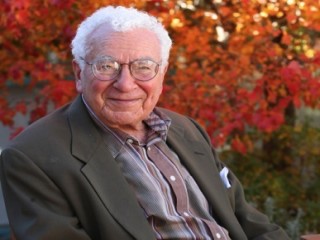
Murray Gell-Mann biography
Date of birth : 1929-09-15
Date of death : -
Birthplace : New York City, New York, U.S.
Nationality : American
Category : Science and Technology
Last modified : 2011-12-07
Credited as : physicist, linguist, quarks
The American physicist Murray Gell-Mann coined the definition "quarks" to describe the triplets of particles that form the cores of atoms. The Nobel Prize winner for Physics in 1969, he helped to develop the Stanford model, which describes the behavior of subatomic particles and their forces.
Murray Gell-Mann was born on September 15, 1929, in New York City of Austrian immigrant parents. A precocious child, he attended a special school for gifted children, where he took a physics course. "It was the dullest course I've ever taken," he told Omni magazine in 1985, "and the only course I've ever done badly in!"
Gell-Mann graduated from school at the age of 15 and entered Yale University, where he sailed through a bachelor's degree to earn his diploma in 1948. Next came graduate study at the Massachusetts Institute of Technology (MIT), where he claims to have found out, for the very first time, what true scientific research can achieve. Totally committed to his work, he completed his doctorate in 1951, and proceeded to the Princeton Institute for Advanced Studies, where he had been awarded a research grant.
Gell-Mann's first academic appointment was in 1952 with the Institute for Nuclear Studies at the University of Chicago, where he started the work on elementary particles that was to bring him the Nobel Prize in physics in 1969. In 1955 he moved to the California Institute of Technology (CalTech). A member of the National Academy of Sciences and the American Academy of Arts and Sciences, Gell-Mann was the recipient of the Dannie Heineman Prize of the American Physical Society in 1959 and of numerous special lectureships and honors.
Gell-Mann was one of the young physicists of the 1950s who tried to bring order into the chaotic field of elementary particles. In 1953 he proposed the invariant quality of "strangeness" to explain the behavior of some of the elementary particles. This quality, he noted, was conserved in strong and electromagnetic interactions but not in weak interactions. Strangeness proved useful in ordering the particles to form a classification chart somewhat analogous
to the periodic table of elements. The chart not only listed families of particles, but by means of it Gell-Mann was able to predict the existence of a hitherto unknown particle, omega-minus, which was detected in 1964.
Physicists began using the term "strange particles" to describe a group of particles, inclusive for K-mesons and hyperons, that exhibited several peculiarities. To explain the anomalously long lifetimes of these particles, Gell-Mann advanced the theory of "associated production": the strong forces responsible for strange particles could act to create them only in batches of more than one at a time. Using his strangeness formulations, Gell-Mann also gave descriptions in detail of numerous decay events of strange particles, as well as prophesying the existence of the neutral xi particle.
In his continuing search for a more general elementary particle theory, Gell-Mann introduced a hypothetical particle, the quark, which is viewed as the fundamental stable constituent of the other particles and therefore is possibly the ultimate building block in the physical universe. Although quarks were not known to exist in the early 1960s when he began to work on particle physics, by the mid-1990s six types, forming three pairs, had been positively identified, and Gell-Mann does not rule out the possibility that there may be many more waiting for discovery.
During the Cold War years, Gell-Mann's work on particle physics was useful to the U.S. defense industries and the military. Notable among his assignments was his antisubmarine work for the Rand Corporation, and his service as a consultant to the Institute for Defense Analysis, especially with regard to the detection of nuclear test detonations.
His formal place of employment, however, was the University of Chicago, where he remained until 1955. The following year he took a professorship at CalTech.
A settled home on the coveted west coast notwithstanding, Gell-Mann left California in 1993 to work at the Santa Fe Institute—an institution he co-founded in 1984— to focus on complex adaptive systems, an interdisciplinary field.
Gell-Mann has written and co-authored many papers. His longer works include: The Discovery of Subatomic Particles, (1983) and The Quark and the Jaguar.
















